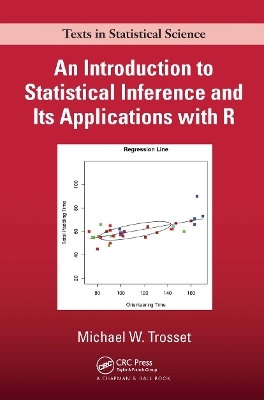
An Introduction to Statistical Inference and Its Applications with R
Seiten
2009
Chapman & Hall/CRC (Verlag)
9781584889472 (ISBN)
Chapman & Hall/CRC (Verlag)
9781584889472 (ISBN)
Explains how statistical methods are used for data analysis and uses the elementary functions of R to perform the individual steps of statistical procedures. This title introduces basic concepts of inference through a study of several important procedures, including parametric and nonparametric methods, analysis of variance, and regression.
Emphasizing concepts rather than recipes, An Introduction to Statistical Inference and Its Applications with R provides a clear exposition of the methods of statistical inference for students who are comfortable with mathematical notation. Numerous examples, case studies, and exercises are included. R is used to simplify computation, create figures, and draw pseudorandom samples—not to perform entire analyses.
After discussing the importance of chance in experimentation, the text develops basic tools of probability. The plug-in principle then provides a transition from populations to samples, motivating a variety of summary statistics and diagnostic techniques. The heart of the text is a careful exposition of point estimation, hypothesis testing, and confidence intervals. The author then explains procedures for 1- and 2-sample location problems, analysis of variance, goodness-of-fit, and correlation and regression. He concludes by discussing the role of simulation in modern statistical inference.
Focusing on the assumptions that underlie popular statistical methods, this textbook explains how and why these methods are used to analyze experimental data.
Emphasizing concepts rather than recipes, An Introduction to Statistical Inference and Its Applications with R provides a clear exposition of the methods of statistical inference for students who are comfortable with mathematical notation. Numerous examples, case studies, and exercises are included. R is used to simplify computation, create figures, and draw pseudorandom samples—not to perform entire analyses.
After discussing the importance of chance in experimentation, the text develops basic tools of probability. The plug-in principle then provides a transition from populations to samples, motivating a variety of summary statistics and diagnostic techniques. The heart of the text is a careful exposition of point estimation, hypothesis testing, and confidence intervals. The author then explains procedures for 1- and 2-sample location problems, analysis of variance, goodness-of-fit, and correlation and regression. He concludes by discussing the role of simulation in modern statistical inference.
Focusing on the assumptions that underlie popular statistical methods, this textbook explains how and why these methods are used to analyze experimental data.
Michael W. Trosset is Professor of Statistics and Director of the Indiana Statistical Consulting Center at Indiana University.
Experiments. Mathematical Preliminaries. Probability. Discrete Random Variables. Continuous Random Variables. Quantifying Population Attributes. Data. Lots of Data. Inference. 1-Sample Location Problems. 2-Sample Location Problems. The Analysis of Variance. Goodness-of-Fit. Association. Simple Linear Regression. Simulation-Based Inference. R: A Statistical Programming Language. Index.
| Erscheint lt. Verlag | 23.6.2009 |
|---|---|
| Reihe/Serie | Chapman & Hall/CRC Texts in Statistical Science |
| Zusatzinfo | 30 Tables, black and white; 72 Illustrations, black and white |
| Sprache | englisch |
| Maße | 156 x 234 mm |
| Gewicht | 1060 g |
| Themenwelt | Mathematik / Informatik ► Mathematik ► Statistik |
| ISBN-13 | 9781584889472 / 9781584889472 |
| Zustand | Neuware |
| Informationen gemäß Produktsicherheitsverordnung (GPSR) | |
| Haben Sie eine Frage zum Produkt? |
Mehr entdecken
aus dem Bereich
aus dem Bereich
Eine Einführung für Wirtschafts- und Sozialwissenschaftler
Buch | Softcover (2022)
De Gruyter Oldenbourg (Verlag)
CHF 41,90


